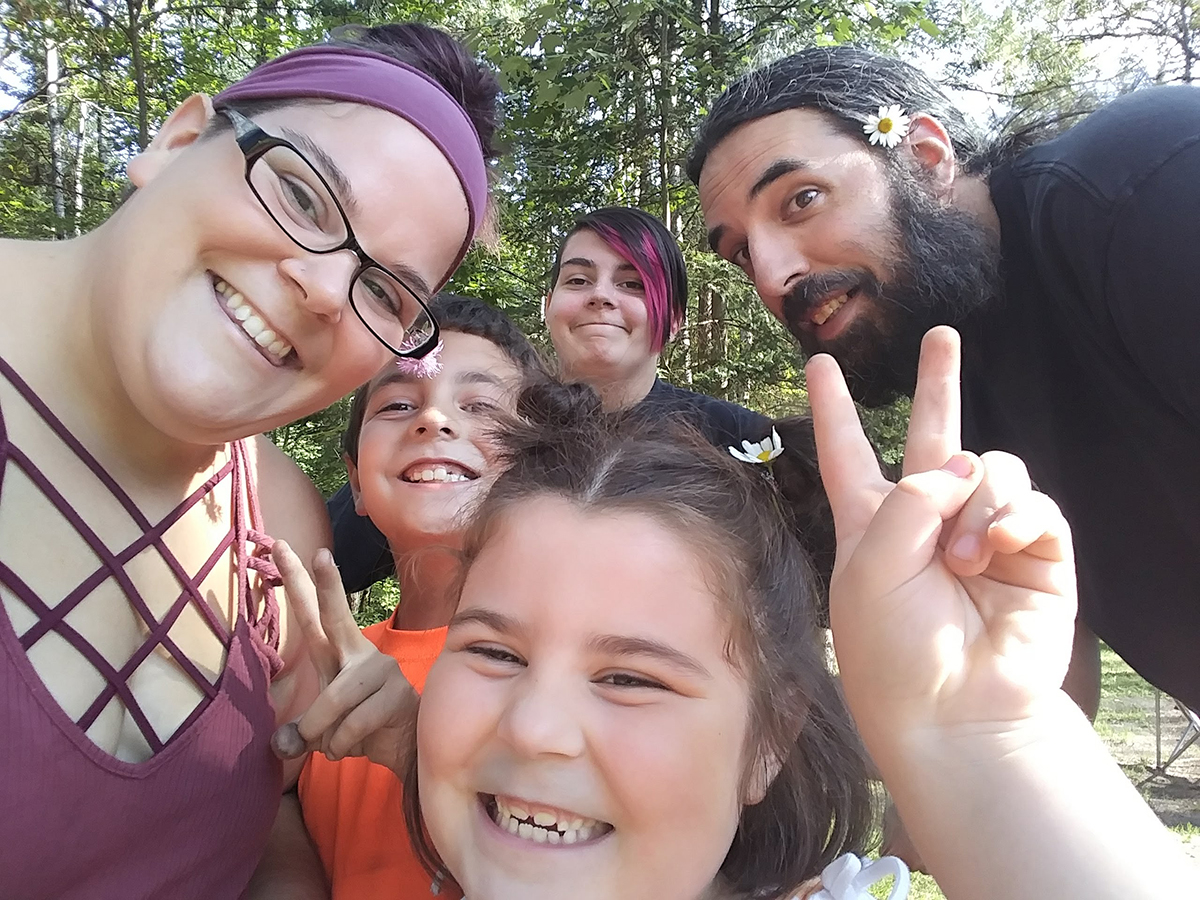Virtual School Enrollment Kept Climbing Even As COVID Receded, New Data Reveal
Online enrollment rose to 170% of its pre-pandemic level in 2020-21, then nudged up further to 176% in 2021-22, according to numbers from 10 states

Help fund stories like this. Donate now!
Updated, Nov. 16
Kristy Maxwell realized something had to change the day she picked her son Levi up from school and found out his teacher had left the autistic kindergartener alone crying and throwing pencils from under his desk.
The Michigan mom switched her son to a school that had a good reputation serving students with disabilities, but things didn’t improve. Because Levi was a “math whiz,” staff ignored his trouble socializing and his difficulty handling the cafeteria’s loud noises, Maxwell said. Meanwhile, she was unsuccessful in lobbying the school to screen her child for autism, a way to secure the extra services required by law for students with disabilities. The mother worried her son might never get the learning support he needed.
Then, in March 2020, the pandemic shifted all classes at his school online and forced the family into an accidental experiment in a new model of education.
During remote school, Levi could get one-on-one attention sitting next to his mother, who had to temporarily stop her work as a massage therapist due to COVID. His younger sister, who struggles with anxiety, could take breaks to pet the family’s dogs.
“When everything shut down and we were forced to go virtual … my two younger kids did really well,” Maxwell said.
“We decided after doing that, since the younger two kids did so well outside of a brick-and-mortar [school], keeping them virtual would be the best way to help them academically.”

The Maxwells, whose three kids are now 9, 11 and 15, are among the thousands of families across the U.S. that tried virtual learning for the first time during the pandemic and are now staying with it.
New data indicate that online schools have had a staying power beyond the pandemic that few observers suspected. While some virtual academies have operated for decades, they saw a well-documented enrollment explosion in 2020-21, the first full school year after COVID, as many virus-wary parents looked to protect their children from infections and anti-mask families sought a way out of face-covering requirements. But in the following year, even as brick-and-mortar schools fully reopened and mask mandates fell, remote schools mostly maintained their pandemic enrollment gains — and in many cases added new seats.
On average across 10 states, virtual school enrollment rose to 170% of its pre-pandemic level in 2020-21, then nudged up further to 176% in 2021-22, according to data obtained by The 74.
The new figures contribute to a more far-reaching understanding because, while several reports have documented the uptick in new fully virtual schools and standalone remote academies offered by districts, scant analyses have provided a national picture of student enrollment in those schools.
‘Looks like it’ll stick’
The trend reveals that for many families virtual learning has become more than a temporary model to get through the pandemic — but rather a long-term option preferred in increasing numbers.
“It looks like it’ll stick,” said Robin Lake, director of the Center on Reinventing Public Education. “In some states, the numbers went up temporarily and came back down a bit. But overall, if [families] are staying for a couple of years, I would expect that they would keep it going.”
Six states in the dataset — Arkansas, Iowa, Massachusetts, Michigan, Minnesota and North Carolina — saw consecutive year-over-year virtual enrollment increases, while four — Florida, Oregon, Wisconsin and Wyoming — saw dramatic upticks in 2020-21, then a slight dip in 2021-22.
“We didn’t know what to expect after the [mask] mandates were lifted, but we maintained our enrollment and we continue to grow,” said Jodell Glagnow, attendance administrator at Wisconsin Virtual Academy.
In Iowa, an extreme case, virtual school enrollment swelled to 373% of pre-pandemic levels in 2020-21 and notched up even further to 388% in 2021-22. The growth corresponded with an increase in the number of approved online schools in the state from three to nearly two dozen over that span, a state Department of Education spokesperson explained.
The data represents K-12 students enrolled in standalone online academies and excludes students taking remote classes offered by their home brick-and-mortar school. The scope, however, varies slightly state by state. For example, the Florida numbers reflect enrollment in the statewide Florida Virtual School, while the Arkansas figures come from its two approved virtual charters and the Michigan tally encompasses students at all 88 providers approved for online instruction.
Oregon was the lone state to provide disaggregated data, revealing white students were overrepresented in the state’s virtual schools in 2020-21, while students with disabilities, those navigating poverty and English learners were underrepresented. Overall, enrollment rose to 172% of pre-pandemic levels that year and reduced slightly the next year.
GeRita Connor runs Lowcountry Connections Academy, a virtual school in South Carolina. Her school opened last year to accommodate the overwhelming demand for online schooling once capacity was reached at its partner academy, South Carolina Connections, which contracts with the same for-profit provider, Connections LLC, an offshoot of publishing and testing giant Pearson.
The families who were newcomers to online academies like hers in the fall of 2021, she said, often hadn’t even considered remote schooling before COVID.
“I think that what happened during the pandemic is that families became more aware of the option of virtual learning,” Connor said. “[It] really opened the doors for those opportunities to exist.”
For the Maxwells in Michigan, Levi stayed in the online option his school maintained through the 2020-21 year, then in the fall of 2021 switched to the statewide Michigan Great Lakes Virtual Academy. His younger sister, Aria, briefly returned to school in person, but switched back to a district-run online option in January 2022. In September, she was able to join her brother at Great Lakes.
Rotten apples?
Experts caution the emerging trend could translate to poor academic outcomes. Virtual academies far predated COVID in some states, often with lackluster track records. And during the pandemic, students who spent the most time away from in-person classes suffered the largest learning setbacks.
Research from the U.S. Government Accountability Office using pre-pandemic data shows students at online schools score far worse on academic tests than their peers learning in-person, even when controlling for factors like race, poverty level and disability status.
To now see more and more families enrolling in online learning worries Heather Schwartz, a researcher at the Rand Corporation who has studied virtual schools during the pandemic.
“Until we have proof the virtual schools can perform just as well — for at least some students — as traditional public schools, yeah, I’m concerned,” she said.
Participating families and administrators, however, attest to a positive impact on student learning at many virtual schools. Levi Maxwell, for example, has seen his grades improve dramatically while learning online, his mother reports. Last year, he wrote his first story by himself, after struggling for years in English.
But Gary Miron, an education professor at Western Michigan University and outspoken critic of virtual academies, believes the negative experiences outweigh the positive ones and is frustrated to see student enrollment continue to rise.
“It defies market theory,” he said. “You’d think consumers would wake up and say, ‘I’m not going to buy these apples. They’re rotten. I’m going to get another producer.’ But they’re not.”
He also warns that many virtual schools — including Connections Academies — have nonprofit “shells” that contract with for-profit management organizations. Those contracts often include costly management fees and six- or seven-figure salaries for top executives, he said.
“Those so-called nonprofits are just incredibly profitable,” Miron said.
Connections Academy spokesperson Chantal Kowalski countered that schools in her organization are public and, like traditional brick-and-mortar schools, are governed by boards that “make all material or budget decisions and publicly post board meeting minutes online.” She added that they “contract with Pearson for online education products and services like curriculum and technology.”
Still, GAO education director Jacqueline Nowicki remains concerned about oversight.
“To the extent that the sector grows and becomes larger, I do think the risk to the federal government grows in terms of accountability,” she said.
Virtual schools, real relationships
The primary concern for Lake, of the Center on Reinventing Public Education, is whether students enrolling in online schools lose out on facetime with teachers. Many remote academies rely heavily on asynchronous lessons and offer fewer hours of live instruction than traditional schools.
“Virtual learning can be a great option, but it isn’t a substitute for connections with adults,” she said. “You have to make sure that the virtual program is providing a lot of student-teacher interaction.”
At their Michigan virtual academy, the Maxwells feel like their needs are being well met. The school has provided more specialists to accommodate her children’s special needs than their brick-and-mortar schools ever did, Kristy Maxwell said. But she admits the energy required to keep her children on task through the school day can be considerable.
“It is a lot of work on my part,” the mom acknowledged.
In a nearby Great Lakes state, seventh grader Helena Warren has also felt satisfied with a recent pivot to the Wisconsin Virtual Academy. She transferred in January 2022 and appreciates how much one-on-one time she gets with her teachers through Zoom breakout rooms or phone calls when she needs extra help.
The middle schooler made the switch because the work at her old school was too “basic and easy,” she said, causing her to tune out and get bad grades, including some C’s and D’s. Now her grades are better and the assignments are more challenging. When she demonstrates mastery of a concept, her teacher asks her to help explain it to her peers, which she enjoys.
“She’s doing higher-grade stuff than she would be doing at a regular brick-and-mortar school,” said her proud mother, Melody Warren, who plans for Helena to stay online indefinitely.
“I think she’s gonna go through high school,” Warren said.
Help fund stories like this. Donate now!

;)
